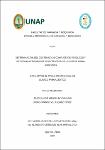Determinación del contenido de compuestos fenólicos y actividad antioxidante de extractos de la raíz de Smilax cumanensis

Date
2024Author
Armas Maytahuari, Joao Junior
Velasquez Perez, Piero Brando
Metadata
Show full item recordAbstract
Objective: To determine the antioxidant activity and the content of phenolic compounds in S. cumanensis root extracts. Methodology: The plant species was collected in the Zungarococha settlement, San Juan Bautista district. Antioxidant activity was assessed using the DPPH free radical scavenging assay, while phenolic compounds were quantified by UV-visible spectrophotometry. Results: A notable concentration of phenolic compounds was revealed in the extracts, including total phenols (16,881.61 mg/100g), flavonoids (12.49 mg/100g), anthocyanins (6.31 mg/100g), and catechins (0.003 mg/100g). Regarding antioxidant activity, the dried S. cumanensis (zarzaparrilla) sample showed an IC50 of 46.33 mg/mL, compared to an IC50 of 83.80 mg/mL for the liquid sample. Conclusion: The dried S. cumanensis sample demonstrated greater antioxidant activity compared to the liquid sample, both in terms of IC50 and antioxidant capacity. These results indicate that the dried sample is more effective in neutralizing free radicals and providing antioxidant benefits. Objetivo: determinar la actividad antioxidante y el contenido de compuestos fenólicos de extractos de la raíz de S. cumanensis. Metodología: La recolección de la especie vegetal se realizó en el centro poblado de Zungarococha, distrito de San Juan Bautista. La actividad antioxidante se determinó con el ensayo de captación de radicales libres (DPPH), mientras que los compuestos fenólicos fueron cuantificados por espectrofotometría Uv-visible. Resultados: se reveló una notable concentración de compuestos fenólicos en los extractos, incluyendo fenoles totales (16881,607 mg/100g), flavonoides (12,493 mg/100g), antocianinas (6,312 mg/100g) y catequinas (0,003 mg/100g). En cuanto a la actividad antioxidante, la muestra seca de S. cumanensis (zarzaparrilla) presentó un IC50 de 46,33 mg/mL, en comparación con un IC50 de 83,80 mg/mL para la muestra líquida. Conclusión: La muestra seca de S. cumanensis mostró una mayor actividad antioxidante en comparación con la muestra líquida, tanto en términos de IC50 como de capacidad antioxidante. Estos resultados indican que la muestra seca es más eficaz en la neutralización de radicales libres y en la provisión de beneficios antioxidantes.
Collections
- Tesis [298]

